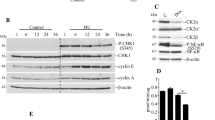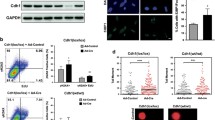Abstract
During S phase, replication forks can encounter several obstacles that lead to fork stalling, which if persistent might result in fork collapse. To avoid this collapse and to preserve the competence to restart, cells have developed mechanisms that maintain fork stability upon replication stress. In this study, we aimed to understand the mechanisms involved in fork stability maintenance in non-transformed human cells by performing an isolation of proteins on nascent DNA-mass spectrometry analysis in hTERT-RPE cells under different replication stress conditions. Our results show that acute hydroxyurea-induced replication blockade causes the accumulation of large amounts of single-stranded DNA at the fork. Remarkably, this results in the disengagement of replisome components from nascent DNA without compromising fork restart. Notably, Cdc45-MCM-GINS helicase maintains its integrity and replisome components remain associated with chromatin upon acute hydroxyurea treatment, whereas replisome stability is lost upon a sustained replication stress that compromises the competence to restart.





Similar content being viewed by others
Abbreviations
- CMG:
-
Cdc45-MCM-GINS
- DSBs:
-
Double-strand breaks
- HR:
-
Homologous recombination
- BIR:
-
Break-induced replication
- ssDNA:
-
Single-stranded DNA
- HU:
-
Hydroxyurea
- FBS:
-
Fetal bovine serum
- PFA:
-
Paraformaldehyde
- RT:
-
Room temperature
- PIC:
-
Protease inhibitor cocktail
- PI:
-
Propidium iodide
- iPOND:
-
Isolation of proteins on nascent DNA
- MS:
-
Mass spectrometry
- WB:
-
Western blot
- QIBC:
-
Quantitative image-based cytometry
- RPC:
-
Replication pausing complex
References
Branzei D, Foiani M (2009) The checkpoint response to replication stress. DNA Repair (Amst) 8:1038–1046. https://doi.org/10.1016/j.dnarep.2009.04.014
Petermann E, Orta MLL, Issaeva N et al (2010) Hydroxyurea-stalled replication forks become progressively inactivated and require two different RAD51-mediated pathways for restart and repair. Mol Cell 37:492–502. https://doi.org/10.1016/j.molcel.2010.01.021
Cortez D (2015) Preventing replication fork collapse to maintain genome integrity. DNA Repair (Amst) 32:149–157. https://doi.org/10.1016/j.dnarep.2015.04.026
Sakofsky CJ, Ayyar S, Malkova A (2012) Break-induced replication and genome stability. Biomolecules 2:483–504. https://doi.org/10.3390/biom2040483
Zou L, Elledge SJ (2003) Sensing DNA damage through ATRIP recognition of RPA-ssDNA complexes. Science 300:1542–1548. https://doi.org/10.1126/science.1083430
Liu Q, Guntuku S, Cui X-S et al (2000) Chk1 is an essential kinase that is regulated by Atr and required for the G2/M DNA damage checkpoint. Genes Dev 14:1448–1459. https://doi.org/10.1101/gad.14.12.1448
Toledo LI, Altmeyer M, Rask M-B et al (2013) ATR prohibits replication catastrophe by preventing global exhaustion of RPA. Cell 155:1088–1103. https://doi.org/10.1016/j.cell.2013.10.043
Lossaint G, Larroque M, Ribeyre C et al (2013) FANCD2 binds MCM proteins and controls replisome function upon activation of S phase checkpoint signaling. Mol Cell 51:678–690. https://doi.org/10.1016/j.molcel.2013.07.023
Forment JV, Blasius M, Guerini I, Jackson SP (2011) Structure-specific DNA endonuclease Mus81/Eme1 generates DNA damage caused by Chk1 inactivation. PLoS One 6:e23517. https://doi.org/10.1371/journal.pone.0023517
Cobb JA, Bjergbaek L, Shimada K et al (2003) DNA polymerase stabilization at stalled replication forks requires Mec1 and the RecQ helicase Sgs1. EMBO J 22:4325–4336. https://doi.org/10.1093/emboj/cdg391
Cobb JA, Schleker T, Rojas V et al (2005) Replisome instability, fork collapse, and gross chromosomal rearrangements arise synergistically from Mec1 kinase and RecQ helicase mutations. Genes Dev 19:3055–3069. https://doi.org/10.1101/gad.361805
Lucca C, Vanoli F, Cotta-Ramusino C et al (2004) Checkpoint-mediated control of replisome-fork association and signalling in response to replication pausing. Oncogene 23:1206–1213. https://doi.org/10.1038/sj.onc.1207199
De Piccoli G, Katou Y, Itoh T et al (2012) Replisome stability at defective DNA replication forks is independent of S phase checkpoint kinases. Mol Cell 45:696–704. https://doi.org/10.1016/j.molcel.2012.01.007
Dungrawala H, Rose KL, Bhat KP et al (2015) The replication checkpoint prevents two types of fork collapse without regulating replisome stability. Mol Cell 59:998–1010. https://doi.org/10.1016/j.molcel.2015.07.030
Remeseiro S, Losada A (2013) Cohesin, a chromatin engagement ring. Curr Opin Cell Biol 25:63–71. https://doi.org/10.1016/j.ceb.2012.10.013
Wu N, Yu H (2012) The Smc complexes in DNA damage response. Cell Biosci 2:5. https://doi.org/10.1186/2045-3701-2-5
Hashimoto Y, Ray Chaudhuri A, Lopes M, Costanzo V (2010) Rad51 protects nascent DNA from Mre11-dependent degradation and promotes continuous DNA synthesis. Nat Struct Mol Biol 17:1305–1311. https://doi.org/10.1038/nsmb.1927
Schlacher K, Christ N, Siaud N et al (2011) Double-strand break repair-independent role for BRCA2 in blocking stalled replication fork degradation by MRE11. Cell 145:529–542. https://doi.org/10.1016/j.cell.2011.03.041
Schlacher K, Wu H, Jasin M (2012) A distinct replication fork protection pathway connects fanconi anemia tumor suppressors to RAD51-BRCA1/2. Cancer Cell 22:106–116. https://doi.org/10.1016/j.ccr.2012.05.015
Quinet A, Lemaçon D, Vindigni A (2017) Replication fork reversal: players and guardians. Mol Cell 68:830–833. https://doi.org/10.1016/j.molcel.2017.11.022
Thangavel S, Berti M, Levikova M et al (2015) DNA2 drives processing and restart of reversed replication forks in human cells. J Cell Biol 208:545–562. https://doi.org/10.1083/jcb.201406100
Zellweger R, Dalcher D, Mutreja K et al (2015) Rad51-mediated replication fork reversal is a global response to genotoxic treatments in human cells. J Cell Biol 208:563–579. https://doi.org/10.1083/jcb.201406099
Ercilla A, Llopis A, Feu S et al (2016) New origin firing is inhibited by APC/CCdh1 activation in S-phase after severe replication stress. Nucleic Acids Res. https://doi.org/10.1093/nar/gkw132
Aranda S, Rutishauser D, Ernfors P (2014) Identification of a large protein network involved in epigenetic transmission in replicating DNA of embryonic stem cells. Nucleic Acids Res 42:6972–6986. https://doi.org/10.1093/nar/gku374
Méndez J, Stillman B (2000) Chromatin association of human origin recognition complex, cdc6, and minichromosome maintenance proteins during the cell cycle: assembly of prereplication complexes in late mitosis. Mol Cell Biol 20:8602–8612. https://doi.org/10.1128/MCB.20.22.8602-8612.2000
Sirbu BM, Couch FB, Feigerle JT et al (2011) Analysis of protein dynamics at active, stalled, and collapsed replication forks. Genes Dev 25:1320–1327. https://doi.org/10.1101/gad.2053211
Lopez-Contreras AJ, Ruppen I, Nieto-Soler M et al (2013) A proteomic characterization of factors enriched at nascent DNA molecules. Cell Rep 3:1105–1116. https://doi.org/10.1016/j.celrep.2013.03.009
Couch FB, Bansbach CE, Driscoll R et al (2013) ATR phosphorylates SMARCAL1 to prevent replication fork collapse. Genes Dev 27:1610–1623. https://doi.org/10.1101/gad.214080.113
Kolinjivadi AM, Sannino V, De Antoni A et al (2017) Smarcal1-mediated fork reversal triggers Mre11-dependent degradation of nascent DNA in the absence of Brca2 and stable Rad51 nucleofilaments. Mol Cell 867:881. https://doi.org/10.1016/j.molcel.2017.07.001
Taglialatela A, Alvarez S, Leuzzi G et al (2017) Restoration of replication fork stability in BRCA1- and BRCA2-deficient cells by inactivation of SNF2-family fork remodelers. Mol Cell 68:414–430. https://doi.org/10.1016/j.molcel.2017.09.036(e8)
Gari K, Decaillet C, Delannoy M et al (2008) Remodeling of DNA replication structures by the branch point translocase FANCM. Proc Natl Acad Sci 105:16107–16112. https://doi.org/10.1073/pnas.0804777105
Vujanovic M, Krietsch J, Raso MC et al (2017) Replication fork slowing and reversal upon DNA damage require PCNA polyubiquitination and ZRANB3 DNA translocase activity. Mol Cell 67:882–890. https://doi.org/10.1016/j.molcel.2017.08.010(e5)
Fugger K, Mistrik M, Neelsen KJ et al (2015) FBH1 catalyzes regression of stalled replication forks. Cell Rep 10:1749–1757. https://doi.org/10.1016/j.celrep.2015.02.028
Sartori AA, Lukas C, Coates J et al (2007) Human CtIP promotes DNA end resection. Nature 450:509–514. https://doi.org/10.1038/nature06337
Hashimoto Y, Puddu F, Costanzo V (2012) RAD51- and MRE11-dependent reassembly of uncoupled CMG helicase complex at collapsed replication forks. Nat Struct Mol Biol 19:17–24. https://doi.org/10.1038/nsmb.2177
Lemaçon D, Jackson J, Quinet A et al (2017) MRE11 and EXO1 nucleases degrade reversed forks and elicit MUS81-dependent fork rescue in BRCA2-deficient cells. Nat Commun. https://doi.org/10.1038/s41467-017-01180-5
Fragkos M, Ganier O, Coulombe P, Méchali M (2015) DNA replication origin activation in space and time. Nat Rev Mol Cell Biol 16:360–374. https://doi.org/10.1038/nrm4002
Meijer L, Borgne A, Mulner O et al (1997) Biochemical and cellular effects of roscovitine, a potent and selective inhibitor of the cyclin-dependent kinases cdc2, cdk2 and cdk5. Eur J Biochem 243:527–536. https://doi.org/10.1111/j.1432-1033.1997.t01-2-00527.x
Ilves I, Petojevic T, Pesavento JJ, Botchan MR (2010) Activation of the MCM2-7 helicase by association with Cdc45 and GINS proteins. Mol Cell 37:247–258. https://doi.org/10.1016/j.molcel.2009.12.030
Kumagai A, Shevchenko A, Shevchenko A, Dunphy WG (2011) Direct regulation of Treslin by cyclin-dependent kinase is essential for the onset of DNA replication. J Cell Biol 193:995–1007. https://doi.org/10.1083/jcb.201102003
Kumagai A, Shevchenko A, Shevchenko A, Dunphy WG (2010) Treslin collaborates with TopBP1 in triggering the initiation of DNA replication. Cell 140:349–359. https://doi.org/10.1016/j.cell.2009.12.049
Labib K (2010) How do Cdc7 and cyclin-dependent kinases trigger the initiation of chromosome replication in eukaryotic cells? Genes Dev 24:1208–1219. https://doi.org/10.1101/gad.1933010
Bianchi J, Rudd SG, Jozwiakowski SK et al (2013) Primpol bypasses UV photoproducts during eukaryotic chromosomal DNA replication. Mol Cell 52:566–573. https://doi.org/10.1016/j.molcel.2013.10.035
Mourón S, Rodriguez-Acebes S, Martínez-Jiménez MI et al (2013) Repriming of DNA synthesis at stalled replication forks by human PrimPol. Nat Struct Mol Biol 20:1383–1389. https://doi.org/10.1038/nsmb.2719
García-Gómez S, Reyes A, Martínez-Jiménez MII et al (2013) PrimPol, an archaic primase/polymerase operating in human cells. Mol Cell 52:541–553. https://doi.org/10.1016/j.molcel.2013.09.025
Araki H (2010) Cyclin-dependent kinase-dependent initiation of chromosomal DNA replication. Curr Opin Cell Biol 22:766–771. https://doi.org/10.1016/j.ceb.2010.07.015
Errico A, Costanzo V (2012) Mechanisms of replication fork protection: a safeguard for genome stability. Crit Rev Biochem Mol Biol 47:222–235. https://doi.org/10.3109/10409238.2012.655374
Lukas C, Savic V, Bekker-Jensen S et al (2011) 53BP1 nuclear bodies form around DNA lesions generated by mitotic transmission of chromosomes under replication stress. Nat Cell Biol 13:243–253. https://doi.org/10.1038/ncb2201
Harrigan JA, Belotserkovskaya R, Coates J et al (2011) Replication stress induces 53BP1-containing OPT domains in G1 cells. J Cell Biol 193:97–108. https://doi.org/10.1083/jcb.201011083
Moreno A, Carrington JT, Albergante L et al (2016) Unreplicated DNA remaining from unperturbed S phases passes through mitosis for resolution in daughter cells. Proc Natl Acad Sci USA. https://doi.org/10.1073/pnas.1603252113
Marians KJ (2018) Lesion bypass and the reactivation of stalled replication forks. Annu Rev Biochem 87:217–238
Zeman MK, Cimprich KA (2014) Causes and consequences of replication stress. Nat Cell Biol 16:2–9. https://doi.org/10.1038/ncb2897
Macheret M, Halazonetis TD (2015) DNA replication stress as a hallmark of cancer. Annu Rev Pathol 10:425–448. https://doi.org/10.1146/annurev-pathol-012414-040424
Byun TS, Pacek M, Yee MC et al (2005) Functional uncoupling of MCM helicase and DNA polymerase activities activates the ATR-dependent checkpoint. Genes Dev 19:1040–1052. https://doi.org/10.1101/gad.1301205
Cortez D (2005) Unwind and slow down: checkpoint activation by helicase and polymerase uncoupling. Genes Dev 19:1007–1012. https://doi.org/10.1101/gad.1316905
Graham JE, Marians KJ, Kowalczykowski SC (2017) Independent and stochastic action of DNA polymerases in the replisome. Cell 169:1201–1213. https://doi.org/10.1016/j.cell.2017.05.041(e17)
Su X, Bernal JA, Venkitaraman AR (2008) Cell-cycle coordination between DNA replication and recombination revealed by a vertebrate N-end rule degron-Rad51. Nat Struct Mol Biol 15:1049–1058. https://doi.org/10.1038/nsmb.1490
González-Prieto R, Muñoz-Cabello AM, Cabello-Lobato MJ, Prado F (2013) Rad51 replication fork recruitment is required for DNA damage tolerance. EMBO J 32:1307–1321. https://doi.org/10.1038/emboj.2013.73
Sun J, Shi Y, Georgescu RE et al (2015) The architecture of a eukaryotic replisome. Nat Struct Mol Biol 22:976–982. https://doi.org/10.1038/nsmb.3113
Schauer GD, O’Donnell ME (2017) Quality control mechanisms exclude incorrect polymerases from the eukaryotic replication fork. Proc Natl Acad Sci 114:675–680. https://doi.org/10.1073/pnas.1619748114
Elvers I, Johansson F, Groth P et al (2011) UV stalled replication forks restart by re-priming in human fibroblasts. Nucleic Acids Res 39:7049–7057. https://doi.org/10.1093/nar/gkr420
Acknowledgements
We thank Dr. Surrallés for Fen1, Dr. Mendéz for MCM3, and Dr. Stracker for SMC1 and Pan-MCM antibodies. We also thank the members of our laboratory for their discussion and the advanced optical microscopy unit of the CCiT-UB for its technical assistance. This work was supported by the grants from the Ministerio de Economia y Competitividad (SAF2013-42742-R, SAF2016-76239-R) for N.A; an FPI fellowship from the Ministerio de Ciencia e Innovación for A.E. and A.Ll.; and an FI fellowship from the Generalitat de Catalunya for S.F.
Author information
Authors and Affiliations
Corresponding author
Ethics declarations
Conflict of interest
The authors declare no competing interests.
Additional information
Publisher's Note
Springer Nature remains neutral with regard to jurisdictional claims in published maps and institutional affiliations.
Electronic supplementary material
Below is the link to the electronic supplementary material.
Rights and permissions
About this article
Cite this article
Ercilla, A., Feu, S., Aranda, S. et al. Acute hydroxyurea-induced replication blockade results in replisome components disengagement from nascent DNA without causing fork collapse. Cell. Mol. Life Sci. 77, 735–749 (2020). https://doi.org/10.1007/s00018-019-03206-1
Received:
Revised:
Accepted:
Published:
Issue Date:
DOI: https://doi.org/10.1007/s00018-019-03206-1




